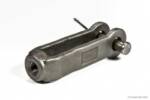
Clevis with cotter pin
It seems like this question is directed toward clevis pins that are used to connect control assemblies, linkages and perhaps hinges. In these applications where rotation of the clevis pin is anticipated, I agree that a washer would protect the retaining device from possible ‘side effects’ of the rotation.
In the case of pins that are used in structural support and bracing applications, I think that it is safe to assume that pin rotation does not occur because the loading is largely static, or at least non-reversing (there is no push-pull going on). I think that it is also safe to assume that there is no load at all on the retaining device (cotter pin) if the pin is installed correctly, and that a washer would provide no added value.
As a side note, it is my belief that what we call headed pins (and the rest of the world calls clevis pins) are described in the AISC Steel Construction Manual as “horizontal or vertical pins” because they can be used in applications where the pin is oriented vertically, with the head bearing on the top surface of the connected member, without concern that the cotter pin could be damaged from physical abuse or corrosion and allow the pin to fall through.
It’d be great to hear your thoughts on this topic in the comments.
Answer submitted by Paul Doherty
Basic Airframe and Powerlant licence ( A & P )
The question is even on the A&P test “All clevis pins require a washer under the cotter key”.